Conjugated Heat Transfer (CHT) in Plate Heat Exchanger CFD Simulation
$80.00 Student Discount
- This problem simulates the Plate Heat Exchanger by ANSYS Fluent software.
- The geometry of the present model is drawn by Design Modeler software and then meshed by ANSYS Meshing software.
- The cell number equals 2,216,379.
- Energy Equation is enabled.
- Both Conduction and Convection happen in the domain (Conjugated Heat Transfer (CHT)).
To Order Your Project or benefit from a CFD consultation, contact our experts via email ([email protected]), online support tab, or WhatsApp at +44 7443 197273.
There are some Free Products to check our service quality.
If you want the training video in another language instead of English, ask it via [email protected] after you buy the product.
Description
Plate Heat Exchanger CFD Simulation (Viscous Heating, CHT), ANSYS Fluent Training
Description
A plate heat exchanger is a kind of heat exchanger that consists of parallel series plates with metal plates in the middle to exchange heat between two fluids. The fluid flows through the space between two adjacent plates. This is the advantage of a Plate Heat Exchanger over conventional heat exchangers in that the fluids are exposed to a larger surface area.
In this project, four solid plates are modeled while four pipes are placed at the corner of the plates. The fluid (water) flows through the pipes at the same velocity and at different temperatures (20 & 40 Celsius) in reverse directions.
The geometry of the solution is designed in Design Modeler software, while all the solids are from one single part. The solids are 2*2m, and their thickness is 0.2m; the pipe’s diameter and length are 0.2m and 1.1m, respectively. Ansys meshing software is used for generating meshes of the solution. The elements are unstructured, and the number of elements is 2216379.
This CFD project is the 2nd episode of the ANSYS Fluent General Training Course.
This CFD project is the 4th episode of the Heat Transfer Training Course.
Methodology: Plate Heat Exchanger CFD Simulation
The pressure-based solver has been employed due to the incompressibility of the fluid. Also, the simulation is independent of Time, so it has performed in steady state form. Moreover, the gravitational effects are ignored. There is convection between water and pipes and conduction in the solids, transferring heat all over the domain. So, Conjugated Heat Transfer (CHT) was studied.
Conclusion
At the end of the solution process, two-dimensional contours and vectors related to water pressure, temperature, turbulence kinetic energy, and velocity are obtained. As depicted, water flows through the pipes with 200k and 400k as a symbol of high and low temperatures in opposite directions.
The very first heat transfer method is convection which is between the fluid and pipe walls. Then it is the conduction turn. The heat that is given from the water transfer inside the solid due to the conduction phenomenon.
The temperature gradient via contour lines is visible in the figures. It should be noted that fluid velocity is an important parameter to affect heat transfer. The more velocity of the water flow, the more convective heat transfer.
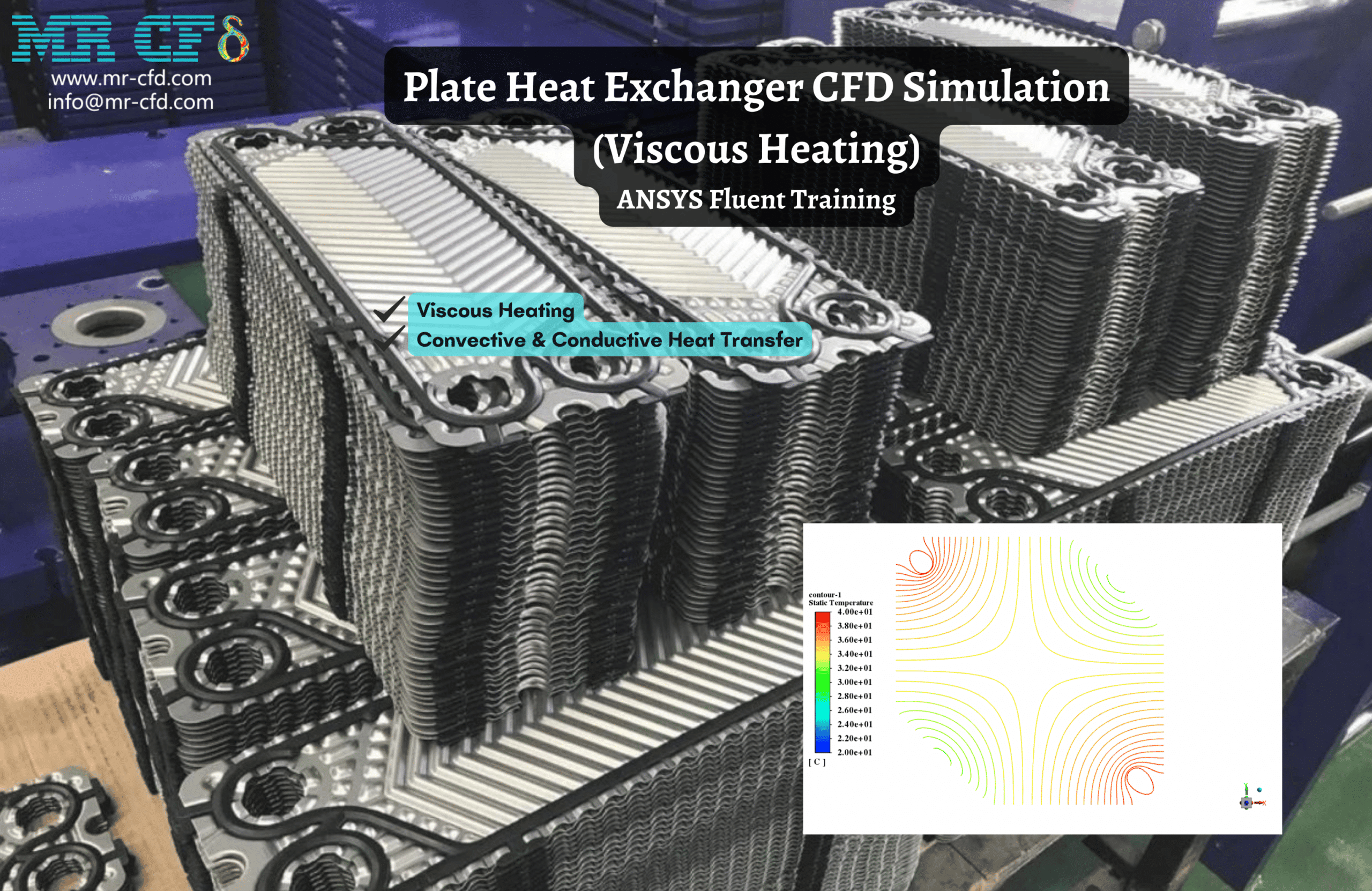
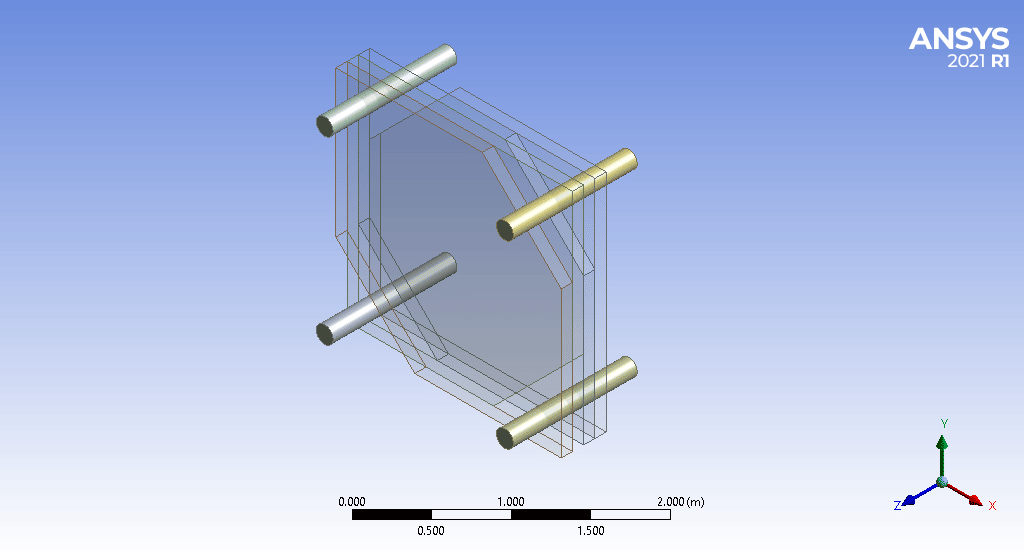
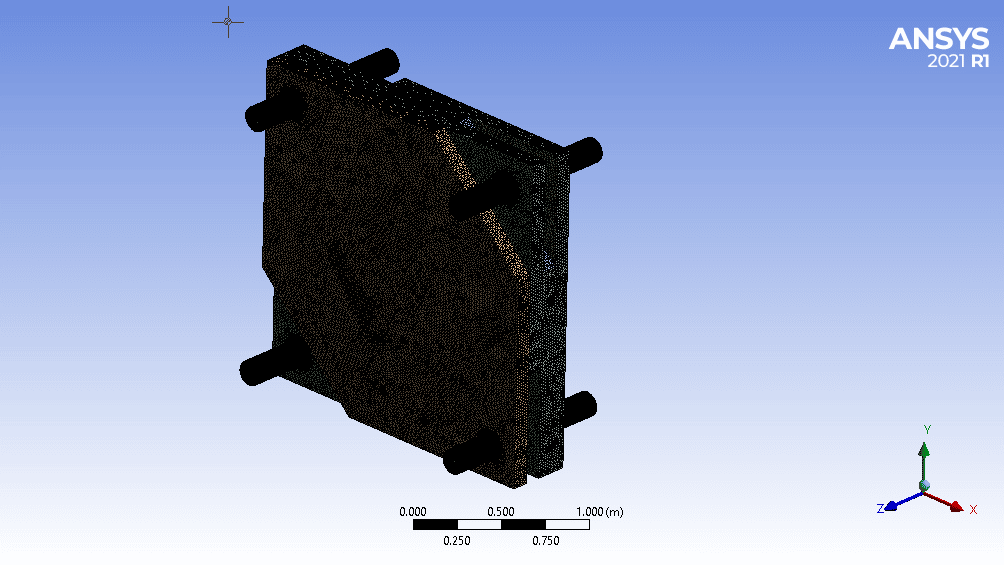
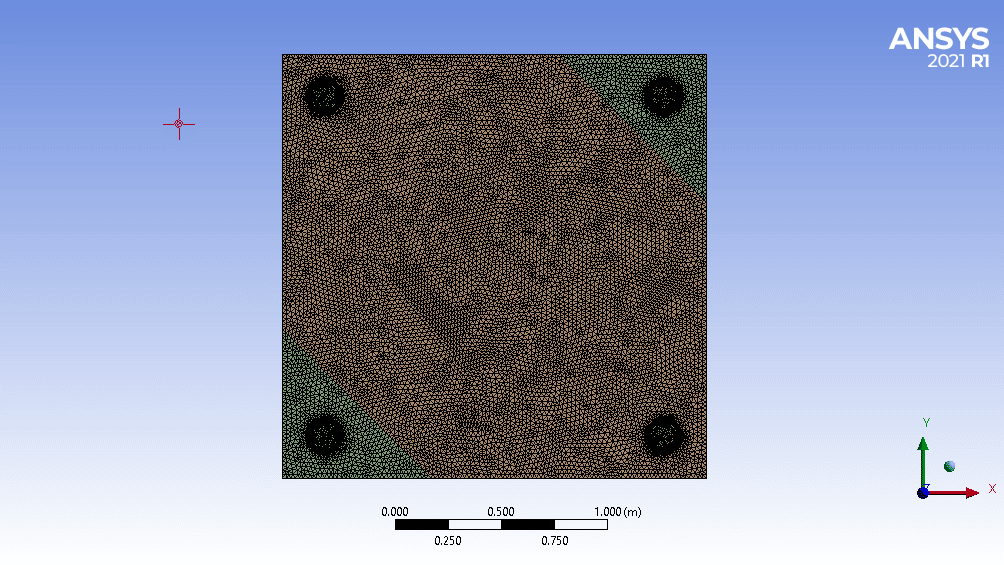
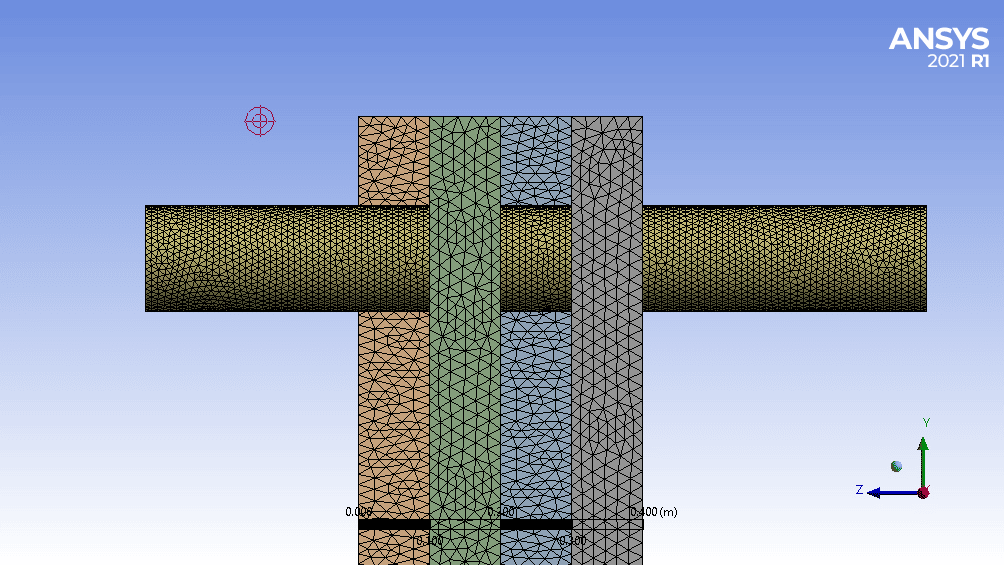
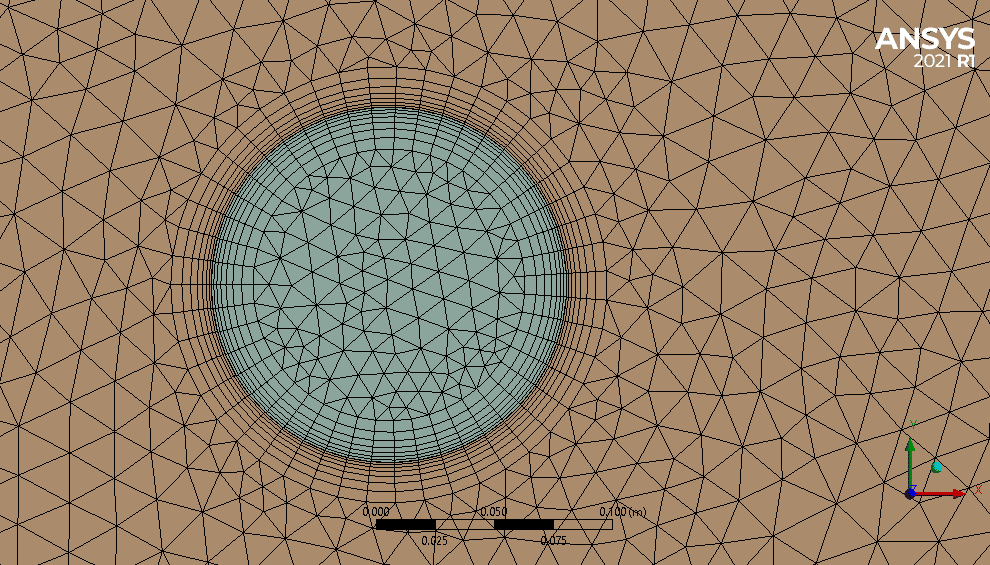
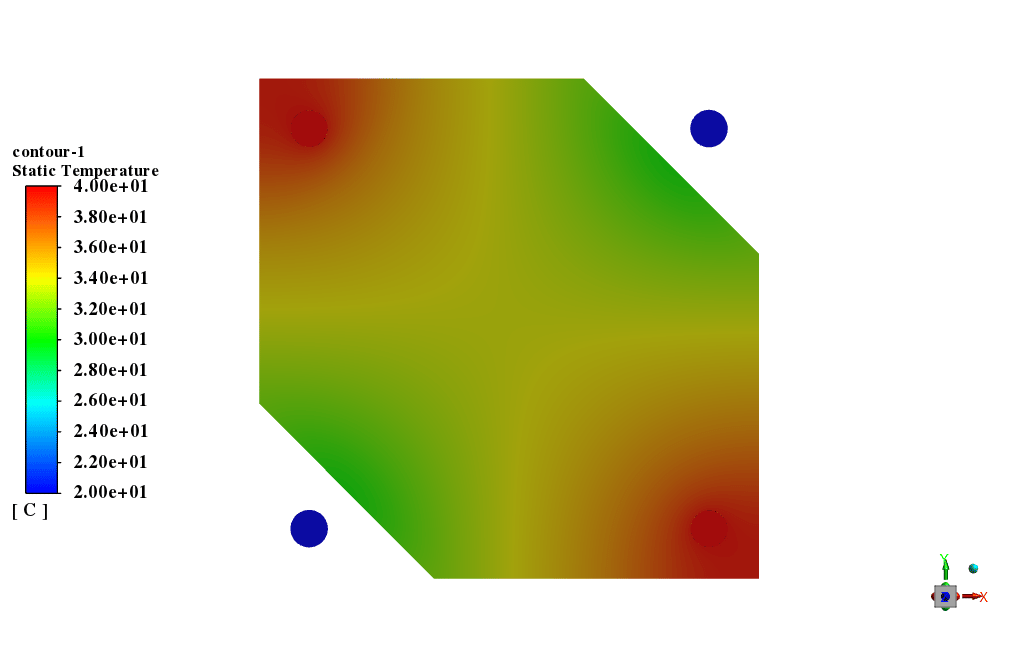
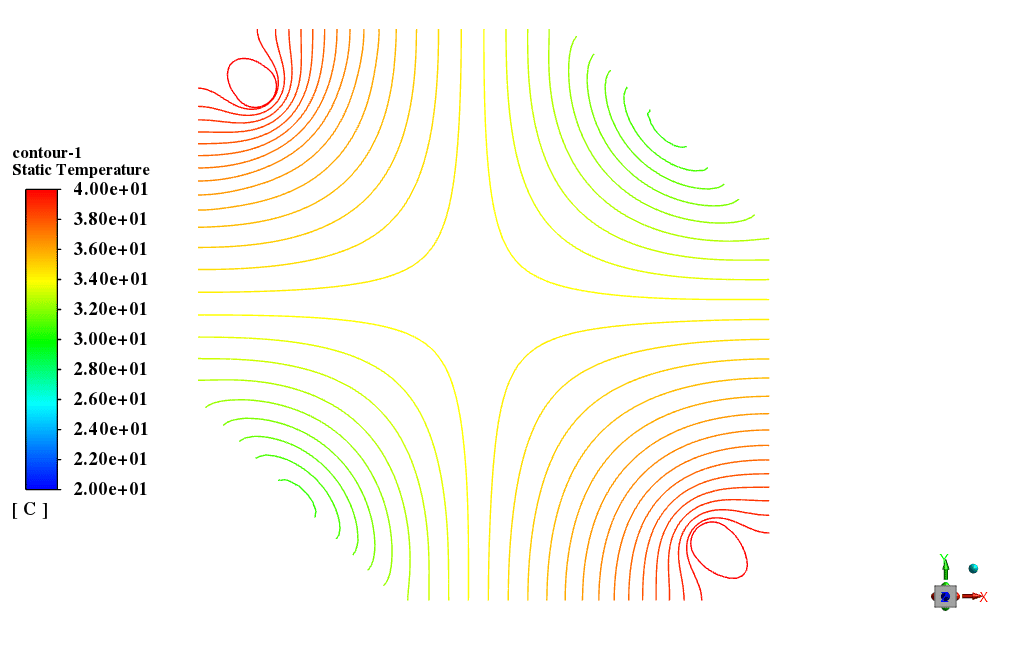
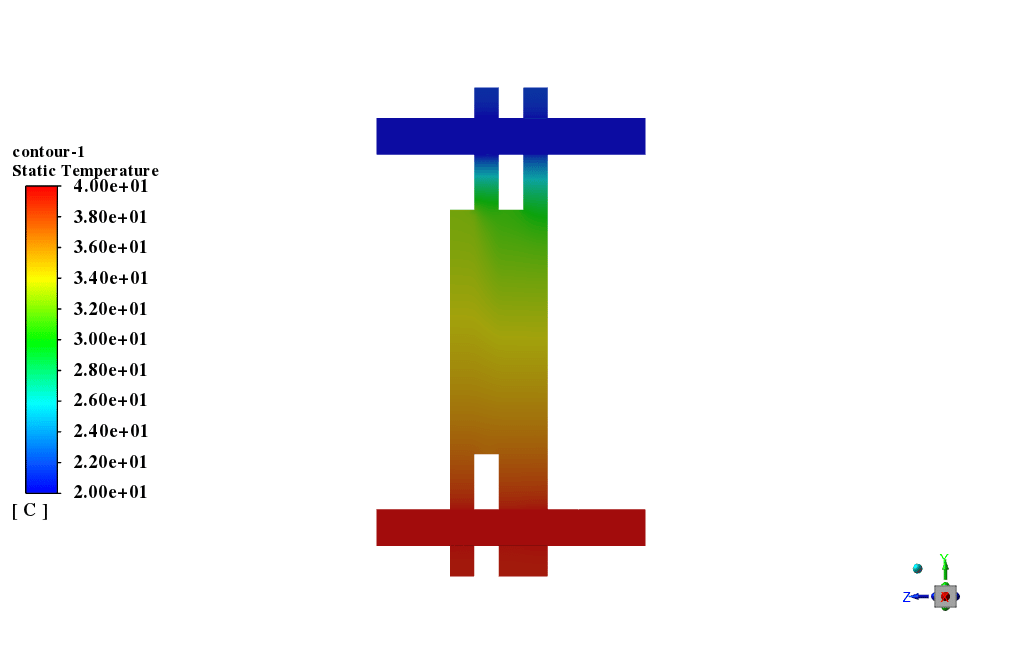
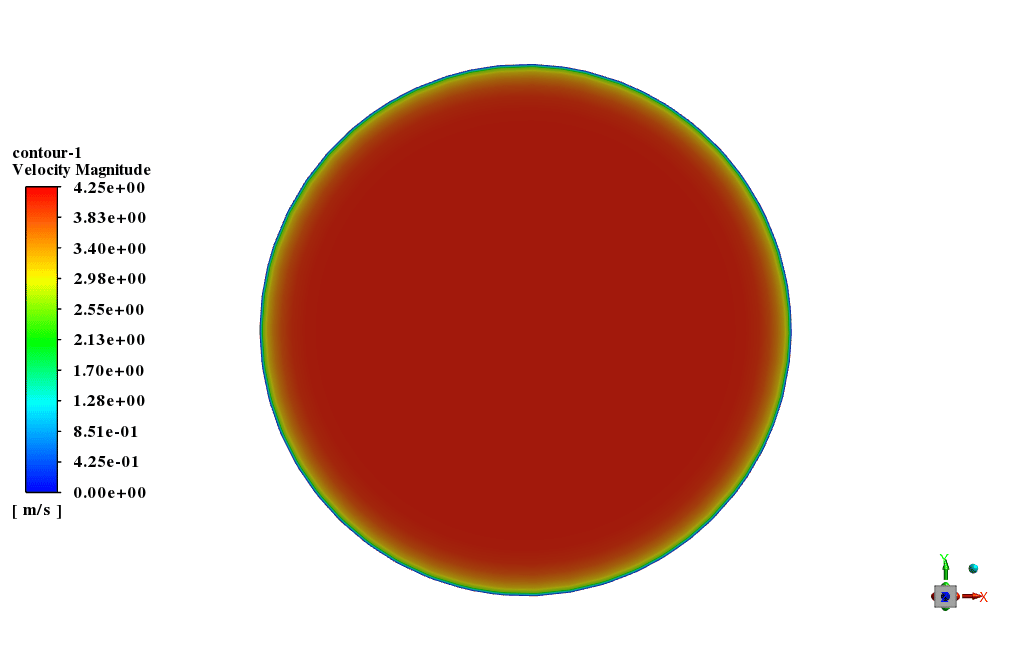
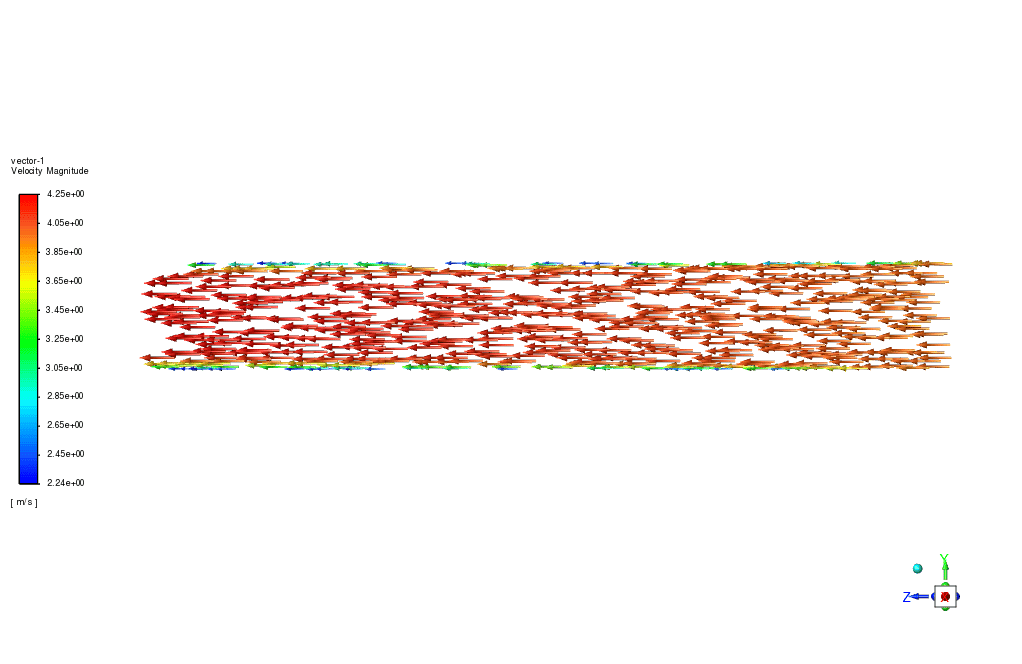



Fabian Kunze –
I especially enjoyed learning how convection and conduction work together in the Plate Heat Exchanger CFD Simulation. The explanation was clear, and it was fascinating to see the temperature gradients through the contour lines. The real-time experience the simulation offers is instrumental in understanding the principles of heat transfer.
MR CFD Support –
Thank you for your positive feedback! We’re delighted to hear that you found the Plate Heat Exchanger CFD Simulation educational and effective in demonstrating the heat transfer concepts. It’s great knowing that the visual representation through contour lines significantly enhanced your learning experience. If you need further assistance or have more questions in the future, don’t hesitate to reach out.
Timothy Swift –
I’m impressed with the depth of simulation in the Plate Heat Exchanger CFD project. The consideration for the convection and conduction heat transfer methods shows the training’s attention to detail. Great work!
MR CFD Support –
Thank you for your positive feedback! We’re delighted to know that you recognize and appreciate the detailed approach to simulating heat transfer in the Plate Heat Exchanger CFD project. Our aim is always to provide comprehensive learning materials for a complete understanding of CFD applications. If you have any more questions or need further assistance, please don’t hesitate to reach out to us.
Rosamond Barrows –
The depth of insights in this simulation is fantastic, making it easier to understand the conjugated heat transfer process in the plate heat exchanger. The level of detail in explaining both methodology and conclusion provides a comprehensive view of the convection and conduction phenomena in the system. Additionally, the application of CFD in optimizing heat exchanger design could significantly impact energy efficiency and performance.
MR CFD Support –
Thank you for your review and for recognizing the details provided in our simulation tutorial. We’re glad to know that it has contributed to a better understanding of the heat transfer process and the importance of fluid velocity in heat exchangers. Your feedback is appreciated, and it motivates us to continue delivering high-quality learning materials. If you have further questions or need more information, please feel free to reach out.
Vergie Kunze –
The training was superbly detailed. The explanation of the convection between water and pipes followed by conduction within the plates helped grasp conjugated heat transfer concepts effectively.
MR CFD Support –
Thank you for leaving a positive review! We’re thrilled to hear that the Plate Heat Exchanger CFD Simulation training helped you understand the concepts of conjugated heat transfer clearly. Your feedback is greatly appreciated, and we’re proud to have been able to provide you with a course that met your learning needs.
Ms. Cara Bosco II –
The Plate Heat Exchanger CFD Simulation was truly insightful! The level of detail in the contour lines and vectors provided a clear visual of the heat transfer processes. The explanation of convection and conduction occurring in successive stages was particularly elucidating. Understanding the effect of water velocity on heat transfer efficiency was an added bonus to my learning experience.
MR CFD Support –
Thank you for your positive feedback! We’re glad to hear that the Plate Heat Exchanger CFD Simulation added to your understanding of heat transfer. The interplay between convective and conductive heat transfer is essential in such systems, and we aimed to illustrate this clearly. It’s great to know the simulation offered you clarity on how velocity impacts heat transfer efficiency. We sincerely appreciate your compliment!
Viva Schimmel –
I’m really impressed by how well the Plate Heat Exchanger CFD Simulation demonstrates heat transfer processes. Could you explain the benefits of using metals in the plates in terms of thermal conductivity?
MR CFD Support –
Thank you for your kind words about the Plate Heat Exchanger CFD Simulation! Metals are generally used in the plates of heat exchangers for their high thermal conductivity. This property allows for efficient transfer of heat between the two fluids as the thermal energy can quickly move through the thin metal plates. This results in a more effective heat exchanger that can handle significant thermal loads with a compact footprint.
Dr. Edwardo Torp III –
I’m really pleased with the Plate Heat Exchanger CFD Simulation course. It was easy to follow, and by seeing the temperature gradient contours, I could appreciate heat transfer principles in action. The inclusion of both conduction and convection created a comprehensive learning experience.
MR CFD Support –
We’re thrilled to hear that the course on Plate Heat Exchanger CFD Simulation met your expectations and provided a detailed understanding of heat transfer principles. Thank you for taking the time to provide feedback, and we’re pleased the course could enhance your learning experience!
Leilani Wisozk –
I appreciate how clearly this complex simulation was explained, especially the step-by-step methodology and the importance of fluid velocity in heat transfer processes!
MR CFD Support –
Thank you for your positive feedback! We’re thrilled to hear that the explanation of the simulation and the steps involved were clear and helpful to you.
Nedra Murphy –
What is the product review?
MR CFD Support –
The CFD simulation of the Conjugated Heat Transfer (CHT) in a Plate Heat Exchanger performed in ANSYS Fluent was extraordinary! It provided valuable insights into thermal transfer efficiency by illustrating fluid dynamics. The clear visualization of temperature gradient and the accurate representation of both convection in fluids and conduction in solid parts enhanced my understanding significantly. I must say, this learning product is essential for anyone studying or working with heat exchangers. Well done, MR CFD Company!
Samanta Bartell –
I recently completed the Plate Heat Exchanger CFD Simulation course, and the details of the convection and conduction processes were well-explained, enhancing my understanding of CHT in plate heat exchangers. One suggestion, for practical application, including case studies with varying flow velocities could provide deeper insights into the effects on heat transfer.
MR CFD Support –
Thank you so much for your kind words and valuable suggestion! We are thrilled to hear that our Plate Heat Exchanger CFD Simulation course has enhanced your comprehension of Conjugate Heat Transfer (CHT). We appreciate your feedback and will consider including more case studies with varying flow velocities in future course content to provide more comprehensive insights into heat transfer dynamics.
Prof. Wilfrid Schaden –
I found the explanation of the conjugated heat transfer in the plate heat exchanger really well-presented. The practicality of various temperature and velocity gradients in the simulation made the concept clear and it’s intriguing to see how these parameters affect heat transfer. Well done on the detailed methodology description too!
MR CFD Support –
Thank you for your kind words! We are delighted to hear that our detailed methodology and presentation of the concept have helped clarify the principles of conjugated heat transfer in a plate heat exchanger. We appreciate your feedback, and if you ever have more questions or need further assistance, we’re here for you!
Michael Wunsch DDS –
I really appreciated how the Plate Heat Exchanger CFD Simulation managed to illustrate the temperature gradient so clearly. The contour lines made it easy to understand the direction and efficiency of the heat transfer, and the impact of fluid velocity was well-demonstrated.
MR CFD Support –
Thank you for your positive feedback on the Plate Heat Exchanger CFD Simulation. We’re delighted to hear that the presented contours and analysis in the simulation helped you gain a clear understanding of the thermal gradient and the effects of fluid velocity on heat transfer. Your insights are valuable, and we’re glad that our product met your expectations.
Dr. Don Wuckert Jr. –
I found the explanation regarding the heat transfer processes very enlightening. Great work showing how the temperature gradients change throughout the system.
MR CFD Support –
We’re thrilled to hear that you appreciated the tutorial on heat transfer in plate heat exchangers. Your feedback encourages us to keep providing high-quality educational content. Thank you for your kind words!
Rubye Kiehn –
I love how thorough the approach is, especially explaining water temperatures and the effects of flow velocity on heat transfer. Great work!
MR CFD Support –
Thank you for your kind words! We are thrilled to hear you found the simulation and its explanations to our Plate Heat Exchanger CFD training insightful and comprehensive. Your feedback is greatly appreciated!
Nelle Smitham –
I found the use of both conduction and convection in this simulation fascinating. How does the velocity of the water impact the effectiveness of heat transfer in the Plate Heat Exchanger model?
MR CFD Support –
The velocity of water in the Plate Heat Exchanger model directly impacts the effectiveness of heat transfer. As the velocity increases, the rate of convective heat transfer also increases. This means that heat is removed from or supplied to the fluid more efficiently. This happens because the higher flow rate enhances the turbulence, which reduces the thermal resistance and therefore increases the heat transfer coefficient.
Prof. Chaz VonRueden –
I’m impressed by the thoroughness of the simulation. Just curious, how significant is the role of the unstructured mesh in the success of a CHT simulation in a heat exchange scenario?
MR CFD Support –
Unstructured meshes are quite advantageous for complex geometries like a plate heat exchanger as they can easily conform to intricate shapes, allowing for more accurate simulation of heat transfer phenomena. Their flexibility facilitates a more fine-tuned computational model, capturing the nuances of conjugate heat transfer effectively.
Turner Hartmann –
I just wanted to express my appreciation for the Plate Heat Exchanger CFD Simulation product. Going through the simulation helped me understand the value of CHT in practical applications. The detailed setup and results were impressive, especially seeing the effects of different water velocities on heat transfer. Using this has helped me greatly in my studies.
MR CFD Support –
Thank you so much for the kind words! We’re delighted to hear that the Plate Heat Exchanger CFD Simulation was helpful for your studies and that you were impressed with the detail and practical applications of CHT. Understanding the influence of fluid velocity on heat transfer is fundamental, and we’re glad our simulation could convey this effectively. Don’t hesitate to reach out if you need further assistance in the future!
Miss Fae McGlynn III –
Wonderful! The project clearly showcases a thorough Conjugated Heat Transfer simulation with detailed methodology and conclusion. The emphasis on velocity impact on heat transfer was particularly insightful.
MR CFD Support –
Thank you so much for your positive feedback! We’re glad to hear that you found the details of the Conjugated Heat Transfer simulation in a Plate Heat Exchanger insightful, especially regarding the impact of fluid velocity on heat transfer. Your satisfaction with our training courses is our top priority!
Chanel Bode –
I found the description of the temperature gradient and flow very informative. Great job in detailing the results!
MR CFD Support –
Thank you for your kind words! We’re delighted to hear that you found the explanation on the temperature gradient and flow dynamics in our Plate Heat Exchanger CFD Simulation tutorial helpful!
Alda Beatty Sr. –
Extremely detailed instruction! Thanks to this Plate Heat Exchanger CFD simulation, I now understand how Conjugated Heat Transfer (CHT) operates in such systems.
MR CFD Support –
We’re glad you found the Plate Heat Exchanger CFD simulation details useful! It’s our goal to provide in-depth training that helps our customers understand complex engineering concepts like Conjugated Heat Transfer (CHT). Thank you for taking the time to leave such positive feedback!
Kyle Pagac –
I’m very impressed with the detailed analysis of heat transfer in the Plate Heat Exchanger CFD Simulation. It’s amazing how the interplay between convection and conduction allows for efficient thermal exchange. Great work on modeling and simulating such complex processes with precision!
MR CFD Support –
Thank you for your positive feedback! We are thrilled to hear that you appreciate the intricate details and the complexity of the CFD simulation in the Plate Heat Exchanger project. It’s our goal to deliver comprehensive and precise simulations that are useful to our customers. If you have any more questions or need further information, don’t hesitate to ask!
Abelardo Dibbert –
Wow, the level of detail in this simulation is impressive. It’s clear that a significant amount of work has gone into it to ensure accurate results.
MR CFD Support –
Thank you for your feedback! We’re delighted that you appreciate the detail and effort invested in the Plate Heat Exchanger CFD Simulation. If you have any more questions or need further clarifications, please don’t hesitate to reach out.
Trisha Abbott –
I’m thoroughly impressed with the clarity of the results from the Plate Heat Exchanger Simulation. The visuals were very informative for understanding the heat transfer process. Great job making complex phenomena easy to grasp!
MR CFD Support –
Thank you very much for your feedback! We’re delighted to hear that our Plate Heat Exchanger Simulation was able to effectively demonstrate the heat transfer process and that the visual results contributed to your understanding. Your satisfaction is our top priority!
Dr. Tiara Bosco –
I’m particularly impressed with the methodology and how you ensured heat transfer across the entire domain. Could you share more about how uniform the temperature distribution was across all the plates?
MR CFD Support –
Thank you for your kind words about the methodology employed in this Plate Heat Exchanger CFD Simulation. Regarding the uniformity of the temperature distribution, the results showed a consistent temperature gradient across the plates in the direction of the fluid flow. The design of the plate heat exchanger promotes an even exposure of each plate to the fluid streams of varying temperatures, which aids in establishing a gradual temperature change from the inlet to the outlet regions across the exchanger.
Eliza Nolan –
I appreciated learning how CHT is applied in heat exchangers through your course. The visualization of the temperature gradient was particularly helpful in understanding the process.
MR CFD Support –
Thank you for your positive feedback! We’re thrilled to hear that our conjugated heat transfer simulation course was instrumental in enhancing your understanding of the heat exchanger process. If you have any more inquiries or need further clarification, please don’t hesitate to ask.
Catherine Casper DVM –
I’m impressed with how the CFD simulation captures both conduction and convection in the heat exchanger. Excellent visuals in the results too!
MR CFD Support –
Thank you for your positive feedback! We are delighted to hear that you found the simulation and the visual results impressive. It’s our goal to provide comprehensive and clear demonstrations of complex CFD concepts, and your comments reassure us that we are achieving this.
Keyshawn Schulist V –
This product sounds fascinating; I have a question about the pipes. What material are they made of in the simulation, and does it affect the heat transfer rate between fluids?
MR CFD Support –
The pipes in the heat exchanger simulation are usually made of metals with high thermal conductivity, such as aluminum or copper. This ensures efficient heat transfer between the fluids. Yes, the material’s thermal conductivity critically affects the heat transfer rate: higher thermal conductivity materials will transfer heat more effectively.
Ashton Schuster –
I found the methodology in the Plate Heat Exchanger CFD Simulation to be quite thorough and the interplay between convection and conduction fascinating. It led to a deeper understanding of the heat transfer processes involved. However, I’d love to know how significant the impact of the water flow velocity on the rate of heat transfer was, based on your findings.
MR CFD Support –
Thank you for the compliment and interest in the Plate Heat Exchanger CFD Simulation’s methodology. The rate of heat transfer is significantly affected by fluid velocity; higher velocities increase the convective heat transfer coefficient, thereby enhancing the rate of heat transfer. Our simulations align with this understanding, showing that the convective heat transfer correlates directly with water flow velocity in the heat exchanger. We certainly appreciate your curiosity and enthusiasm towards our simulation works!
Mitchell Rowe –
I have learned a lot from the Plate Heat Exchanger CFD Simulation course. The elements were explained clearly, which made it easier to understand the concept of Conjugated Heat Transfer!
MR CFD Support –
We’re excited to hear that our Plate Heat Exchanger CFD Simulation course was helpful for you! Understanding Conjugated Heat Transfer is crucial for many engineering applications, and we’re happy that we could make the learning process clear and understandable. Thank you for taking the time to provide your positive feedback!
Aron Lehner –
I just completed the Plate Heat Exchanger CFD Simulation product! The simulations clearly demonstrated the heat exchange process and the contour animations for temperature and flow patterns were exceptionally insightful. Kudos to the team for creating such detailed and informative content!
MR CFD Support –
Thank you for your positive feedback on our Plate Heat Exchanger CFD Simulation training product! It means a lot to us that our content has provided you with a clear and informative experience. We are thrilled to hear that the animations were helpful in enhancing your understanding. We hope our simulation products continue to assist you in your future projects.
Audie Thiel Sr. –
The explanation of how well the Plate Heat Exchanger simulation models the heat transfer processes between the fluids and the solid plates is commendable. It clearly illustrates the importance of having adequate surface area for heat exchange and the role of fluid velocity in the efficiency of the system. The imagery of gradient temperature lines helps in visualizing the heat conduction through the plates. All around, it seems like an excellent learning tool for understanding the principles of heat exchange.
MR CFD Support –
We appreciate your positive feedback! It’s fantastic to hear that our Plate Heat Exchanger CFD Simulation helped you grasp the complex mechanics of heat transfer processes. Understanding of nuances like the impact of fluid velocity on heat transfer efficiency can indeed deepen with the visual aids provided. Thank you for acknowledging our efforts to create an intuitive learning product. If you have further questions or require additional information, don’t hesitate to ask. Keep learning and exploring!
Mr. Lonny Adams –
Thank you for such a comprehensive training product. The balance between theory and practical application aided greatly in understanding CHT in plate heat exchangers.
MR CFD Support –
Thank you very much for your positive feedback! We’re thrilled to hear that you found our training material comprehensive and useful for understanding Conjugated Heat Transfer in plate heat exchangers. Your satisfaction is our top priority!
Brooks Wolff –
I am thoroughly impressed with how the Plate Heat Exchanger CFD Simulation captures the essence of conjugated heat transfer. The explanation of how heat is transferred through convection in the fluid and by conduction in the solids helped me grasp the complex interactions within a plate heat exchanger. Excellent work.
MR CFD Support –
Thank you for your kind words! We’re overjoyed to hear that our Plate Heat Exchanger CFD Simulation was able to help you understand the intricacies of conjugated heat transfer. Our goal is to provide clear and accurate educational material, and your feedback validates our efforts. If you need further information or assistance with our products, please don’t hesitate to reach out!
Keegan Funk –
This CFD simulation on Plate Heat Exchanger sounds fascinating! From the detailed design and methodology implications, were there any specific challenges during the mesh generation given the unstructured mesh nature?
MR CFD Support –
Thank you for your kind words and interest! Mesh generation for a Plate Heat Exchanger can indeed be challenging, especially with unstructured mesh on intricate geometries. For this simulation, a meticulous strategy was used to ensure mesh quality and refinement at critical areas, such as near the fluid-solid boundaries where CHT occurs, while also maintaining a reasonable total element count. This balance was crucial to provide accurate results without excessive computational costs.
Prof. Lessie Nitzsche DDS –
The training material for the plate heat exchanger was equally informative and intriguing! The detailed explanation of CHT included with real-world applications was particularly educational. Excellent resource for visualizing temperature gradients and understanding the mechanics of heat exchange in these systems.
MR CFD Support –
Thank you for your positive review! We’re delighted that you found the plate heat exchanger CFD simulation and the explanation surrounding Conjugated Heat Transfer valuable for understanding heat exchange mechanics. Your feedback is greatly appreciated, and it motivates us to continue creating high-quality educational resources.
Carroll Schneider PhD –
I’m truly amazed at how well the Plate Heat Exchanger CFD Simulation training was put together. The step-by-step guidance and detailed explanation made it easy to understand complicated processes like viscous heating and CHT. It’s impressive how the course logically progressed from the fundamentals to more complex aspects of the heat exchange process.
MR CFD Support –
Thank you for your positive review! We’re thrilled to hear that our Plate Heat Exchanger CFD Simulation training met your educational needs and helped enhance your understanding of viscous heating and Conjugated Heat Transfer. Good to know that the structured approach of the course made the complex concepts more accessible. We appreciate your feedback and hope you continue to find our products beneficial for your learning journey.
Dr. Manley Beatty DVM –
Just wanted to say you folk did an awesome job with the Plate Heat Exchanger CFD Simulation product. The details in the results like the temperature gradients and flow patterns in the heat exchanger were really clear and helpful for understanding the complex heat transfer processes involved.
MR CFD Support –
Thank you so much for your kind words! We’re glad to hear that our product was helpful and provided you with a clear understanding of heat transfer processes within plate heat exchangers. Your feedback is very much appreciated!
Kaitlin Fahey –
I just completed my coursework using the CHT in Plate Heat Exchanger CFD Simulation, and I must say I am impressed! The detail of the simulation and the clear explanation of concepts like viscous heating and heat transfer methods were incredibly helpful. Understanding how convection and conduction work together in a practical scenario like a plate heat exchanger was fascinating. The project files and meshing were of excellent quality, making it easier for me to follow along and learn the material.
MR CFD Support –
We are thrilled to hear that our Conjugated Heat Transfer simulation in a Plate Heat Exchanger has contributed to your understanding and coursework. It’s wonderful to know the quality of the project files and meshing met your expectations. We pride ourselves on the clarity of our educational content, and your satisfaction means everything to us. Thank you for sharing your positive experience, and should you need further assistance or seek to deepen your knowledge, please don’t hesitate to reach out.
Beau Padberg –
After studying the Plate Heat Exchanger tutorial, I observed water temperatures of 20C & 40C. I’m curious, how does altering these input temperatures affect overall heat transfer efficiency?
MR CFD Support –
The input water temperatures play a critical role in the overall efficiency of heat transfer in the plate heat exchanger. By altering these temperatures, you affect the thermal gradient which drives the heat transfer across the exchanger. A higher temperature difference between the two fluids can lead to more efficient heat transfer as it increases the driving force for conduction and convection processes. Therefore, changing the input temperatures will significantly impact the rate of heat transfer and subsequently the effectiveness of the heat exchanger. It’s essential to optimize these temperatures according to the desired heat exchange performance objectives.
Mr. General Aufderhar –
The visuals in the training were incredibly helpful. Seeing the temperature gradient through the contour lines really solidified my understanding of how CHT operates in plate heat exchangers. Huge thanks!
MR CFD Support –
We’re so pleased to hear that our visual materials aided in enhancing your comprehension of Conjugated Heat Transfer in plate heat exchangers! It’s always encouraging to receive positive feedback about our training programs. Thank you for your appreciation!
Ross Weber –
I’ve used the simulation for my final year project and it worked wonderfully! The tutorial was clear and got me the exact results I was aiming for.
MR CFD Support –
Thank you so much for your positive feedback! We’re thrilled to hear that our simulation contributed to your project’s success and that you found the tutorial to be helpful. We always strive to provide clear and effective learning resources, and it’s rewarding to know you had excellent results. We wish you all the best with your future studies and projects!
Chauncey Stanton –
Wow, the complete simulation of a plate heat exchanger’s operations with conjugated heat transfer sounds incredibly thorough! This level of detail must provide excellent insights for understanding the efficiency of heat exchangers in different scenarios.
MR CFD Support –
Thank you for your positive review! We’re glad to hear that our simulation met your expectations and provided valuable information on the intricacies of heat transfer in plate heat exchangers. If you need further assistance or have any more feedback, feel free to reach out.
Joseph Hammes –
The training was excellent! It described step by step how to set up and perform a CHT simulation in a plate heat exchanger. I appreciated the depth of information on convection and conduction processes.
MR CFD Support –
Thank you for your positive feedback! We’re thrilled to hear that our training on Conjugated Heat Transfer in a plate heat exchanger was helpful to you. If you have any further questions or need more information, please feel free to reach out. Your success is our top priority!
Ferne Kovacek IV –
This Plate Heat Exchanger simulation helped me reinforce the theory I learned in classes! The heat transfer seen through the contours was amazing. It was great seeing the convection within the pipes and how it affected the solids.
MR CFD Support –
Thank you for the positive feedback on our Plate Heat Exchanger CFD Simulation tutorial! We’re thrilled to hear that our training course was effective in reinforcing your theoretical knowledge and that you were impressed with the visualization and understanding of the heat transfer process. If you have further inquiries or need more resources, do not hesitate to reach out!
Yazmin Daugherty –
I loved the detailed explanation on how heat transfer occurs in the Plate Heat Exchanger simulation. It was fascinating to see the temperature gradients and understand the roles of convection and conduction. Great job on providing such an informative analysis!
MR CFD Support –
Thank you for your positive feedback! We’re thrilled that the Plate Heat Exchanger CFD simulation details were insightful and that you appreciated the explanation of the heat transfer process. If you’re interested in further CFD analysis or similar simulations, we’re here to assist you.
Graham Pacocha DDS –
This Plate Heat Exchanger simulation sounds fascinating. Can you specify if different materials can be used for the plates, and how would that affect heat transfer?
MR CFD Support –
In this Plate Heat Exchanger simulation, different materials can indeed be utilized for the solid plates. The choice of material would impact the conduction rate as different materials have varying thermal conductivities. Materials with higher thermal conductivity will transfer heat more efficiently, thereby potentially improving the heat exchanger’s performance.
Deven Raynor –
The explanation on the conjugated heat transfer process was clear and very informative. Great work on detailing the physics and methodology behind the Plate Heat Exchanger CFD simulation.
MR CFD Support –
Thank you for your kind words! We’re delighted to hear that our explanation on the conjugated heat transfer process in the Plate Heat Exchanger CFD simulation was informative. We strive to provide detailed and understandable content to help our customers comprehend complex concepts. If you have any more questions or need further assistance, feel free to ask!
Joanne Weimann –
This course provided a holistic understanding of how CHT occurs in a plate heat exchanger. The ability to visualize the temperature gradient with contour lines considerably enhanced comprehension of conduction and convection processes—the simulations succinctly illustrated the dynamic relationship between water velocity and heat transfer efficiency.
MR CFD Support –
We’re delighted to hear that the visual aspects of the Plate Heat Exchanger CFD Simulation course aided in your understanding of Conjugated Heat Transfer (CHT). It’s our aim to provide intuitive learning experiences that clearly illustrate complex concepts, and your feedback validates our efforts. Thank you for taking the time to share your positive experience!